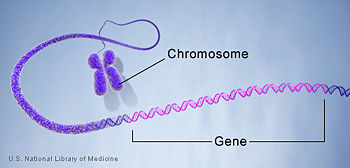Gene

In 1909, Danish botanist Wilhelm Johanssen coined the word gene for the hereditary unit found on a chromosome. Nearly 50 years earlier, Gregor Mendel had characterized hereditary units as factors— observable differences that were passed from parent to offspring. Today we know that a single gene consists of a unique sequence of DNA that provides the complete instructions to make a functional product, called a protein. Genes instruct each cell type— such as skin, brain, and liver—to make discrete sets of proteins at just the right times, and it is through this specificity that unique organisms arise. [1]
A gene (from the Greek γεννάω gennao, to beget or produce) is generally viewed as the basic physical and functional unit of heredity.[2] Genes, which are made up of DNA, act as blueprints to make molecules called proteins. Scientists sometimes consider other segments of DNA genes as well, such as the segments that encode blueprints for nucleotide polymer structures like ribosomal RNA (rRNA) and transfer RNA (tRNA), or DNA sites at which information concerned with gene regulation and expression is located.
History of Genetics
Gregor Mendel, Watson & Crick, etc..
Chromosomes
In eukaryotes (organisms whose cells have nuclei, such as plants, yeasts and animals), genes are usually arranged together in multiple long thread-like arrangements called chromosomes. Chromosomes typically come in pairs, and there can be hundreds, sometimes thousands, of genes in one chromosome. Prokaryotes (organisms such as common bacteria) generally have a single large circular chromosome, but often possess other miniature chromosomes called plasmids.
Alleles and Dominant Genes
Alleles are alternative versions of the same gene with differences in their sequence of DNA bases. These differences account for variations in inherited characteristics.
Sexually reproducing organisms inherit one allele from each parent, and so have a total of two alleles for each gene. When sperm and egg cells are generated, each is given only one allele for each gene. These cells are commonly referred to as haploid cells. When the sperm fertilizes the egg, a cell called a zygote is produced. Zygotes, like most of the cells that subsequently divide, grow and form a complete organism, are referred to as diploid. Generally, when a normal haploid cell contains n chromosomes, the resulting fertilized dipliod cell will contain 2n chromosomes. For more information on specific situations where this does not happen, see nondisjunction.
An organism with two identical copies is said to be homozygous for that gene, and is called a homozygote. An organism with two different alleles for a gene is said to be heterozygous for that gene, and is called a heterozygote.
In a heterozygote, when one allele determines the appearance of the individual it is called the dominant allele. When the other has no noticible effect it is called the recessive allele. Another term sometimes used for homozygous organisms is "true breeding" because of the certainty that their offspring will posess the given trait. The appearance of a given trait is referred to as the phenotype of the individual, whereas the complete set of alleles (dominant and recessive) is referred to as the genotype.
In reality, a more complex combination of gene expression is common. In some cases, the offspring's appearance is found to be in between the two appearances. This can be seen in cases such as hybrids of red and white roses that can appear pink. This phenomonon is called incomplete dominance.
In other cases, both traits are always visible. This phenomonon is called codominance. Codominance can be seen in blood typing in humans. People may have one or both of two carbohydrates (named A and B, and specified by their particular alleles) attached to the surface of their red blood cells. If neither carbohydrate is present, the person is said to have type O blood. The person is said to have type A blood if the A carbohydrate is present, and type B blood if the B is present. An individual that has inherited A and a B genes, will have both carbohydrates present on all cells, and is said to have type AB blood.
Gene Structure
Each DNA is made up of the sugar 2'-deoxyribose linked to a phosphate group and one of the four bases: guanine (G), adenine (A), thymine (T), and cytosine (C) These nucleotides are placed in a unique order to code for all of the genes in all living organisms.
Transcription and Translation
Molecular Genetics
Human Genetics
In humans, genes vary in size from a few hundred DNA bases to more than 2 million bases. The Human Genome Project has estimated that humans have between 20,000 and 25,000 genes. Most genes are the same in all people, but a small number of genes (thought to be less than 1 percent of the total) are slightly different between individuals.
References: